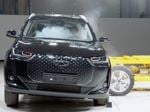Witnessing Carlos Ghosn talk about the changes Nissan has undertaken during his few years as chief executive, you could be forgiven for thinking turning around an ailing company was easy.
His vision is so clear and he explains his aims in such simple terms, that the crisis Nissan was in before Renault helped bail it out seems far-fetched.
Almost every decision seems to be grounded in whether it is likely to improve the company’s profits.
With Ghosn’s single-minded mission to transform the company over the past few years his achievements are easy to take for granted, but it was only a few years ago that Nissan had £8bn of debt.
Nissan is now entering the final stages of Ghosn’s strategy to turn around the company’s fortunes and talk is focusing on the next three years, preserving what has already been achieved and building on it for the future.
Its plans will ensure models introduced in the UK are modern and innovative designs like the Micra and X-trail – and less like the Almera and Maxima QX.
Instigated soon after Ghosn was installed in Nissan five years ago following Renault taking a stake in the firm, the objectives of the Nissan 180 plan have almost been achieved.
It contained three separate targets to be fulfilled by September 2005 – the ‘1’ in the 180 referring to one million extra sales a year compared with 1999; the ‘8’ signifying an operating margin of 8% and the ‘0’ denoting zero debt.
Ghosn says: "We have already achieved two of these objectives and the one million additional sales will be measurable between October 2004 and September 2005 – the final 12 months of the plan. But we have many more models coming soon.
"We sold three million cars in 2003 with 10% growth. Our growth has been sustained through new products. Our 11.1% operating margin is at the top level in our industry as is our 21.3% return on investment capital."
He appears confident of reaching his target in the next 12 months and is looking towards the next objective beginning in April 2005.
"Our new ‘value up’ plan has already been announced," he said. "In this plan we will be selling 4.2m cars a year by 2007. We will continue with our top level operating margin through to 2007 as well as a 20% return on investment.’
One of the main areas where Nissan has been able to implement significant reductions in cost is by rationalising the number of platforms – or sets of components – for its vehicles.
In 1999, the worldwide Nissan range was built from 24 different platforms, with the top five accounting for about 62% of its vehicles.
In 2005 there will be just 15 platforms, with the five most commonly used providing the basis for 91% of its vehicles.
A significant change in direction has been a reluctance to impose vehicles on markets not suited to them and instead introduce vehicles where demand is led by consumers.
This is perhaps best illustrated by the Murano sport utility vehicle which will make its UK debut in 2005.
"The Murano has, little by little, won over those people within the company whose attitude might have been too conservative," said Ghosn. "It was designed for sale in the United States and sales had a slow start because it was so different and people needed to become accustomed to seeing it.
"Now we are selling over 5,000 Muranos a month and all those who said they did not want to sell it for whatever reason have started talking about possible opportunities. The car will be sold in Japan and Europe.
"We don’t push cars – we try to get the individual markets to ‘pull’ them. In the value up plan, most of our product line-up will become global. We will prepare our cars to go on sale in almost any country in the world.
"Every car will be designed with the capability to go global because people can change their minds about vehicles.
"The next Skyline GTR will be global. It doesn’t mean we will sell the car everywhere but it will be prepared for sale everywhere."
At the same time there is an iron discipline to refrain from chasing volume or market share. Ghosn says there was a time a few years ago when Nissan showrooms offered ‘the best deals in town’, but this is no longer the case.
However, he says customers are more confident when they know the manufacturer has a secure future and do not resent high profit margins.
"I have never heard of anyone going to a showroom saying they are prepared to hand over more than the asking price because the manufacturer is not making any money. Likewise, I have never heard of anyone who says they want to pay less because the company is too profitable.
"People are not comfortable buying a car if the company is in financial trouble. We want to give customers the best value but also be profitable so we can invest in new products and go into new segments of the market.
"If the company is profitable, growth will come as a consequence. Volume is not that important. We just have to make sure we sell the cars well.
"We have 28 new cars coming over the next few years, and seven of them are completely new and not replacements for anything in our line-up."
Among the new models on their way to the UK, Murano aside, is a European version of the Pathfinder sport utility vehicle, due to be unveiled next month at the Paris Motor Show.
The Discovery-size car will be built in Barcelona alongside new versions of the Nissan Pickup next year, will have seven seats, a common rail turbodiesel and will target buyers of the Land Rover. It will join two heavy duty 4x4s in the Nissan line-up – the Patrol and the Terrano – as well as the ‘soft-roader’ Murano and X-trail.
Meanwhile a sport utility crossover appears increasingly likely to become one of the replacements for the worthy-but-dull Almera, based on the Qashqai concept seen at this year’s Geneva Motor Show.
"There will be a number of successors to the Almera because there is no way we can make money from another Almera," says Ghosn.
"We have an idea to build a crossover vehicle that will become a replacement for the Almera, but the location for production is undecided.
"We are moving into a position to take the top place in Europe for 4x4s, with the Murano, X-trail and many other cars coming. We will have a full range of 4x4s and will be a significant player."
Next year, in addition to heading up Nissan, Ghosn will also take on responsibility for running Nissan’s alliance partner, Renault, when current chief executive Louis Schweitzer retires.












Login to comment
Comments
No comments have been made yet.